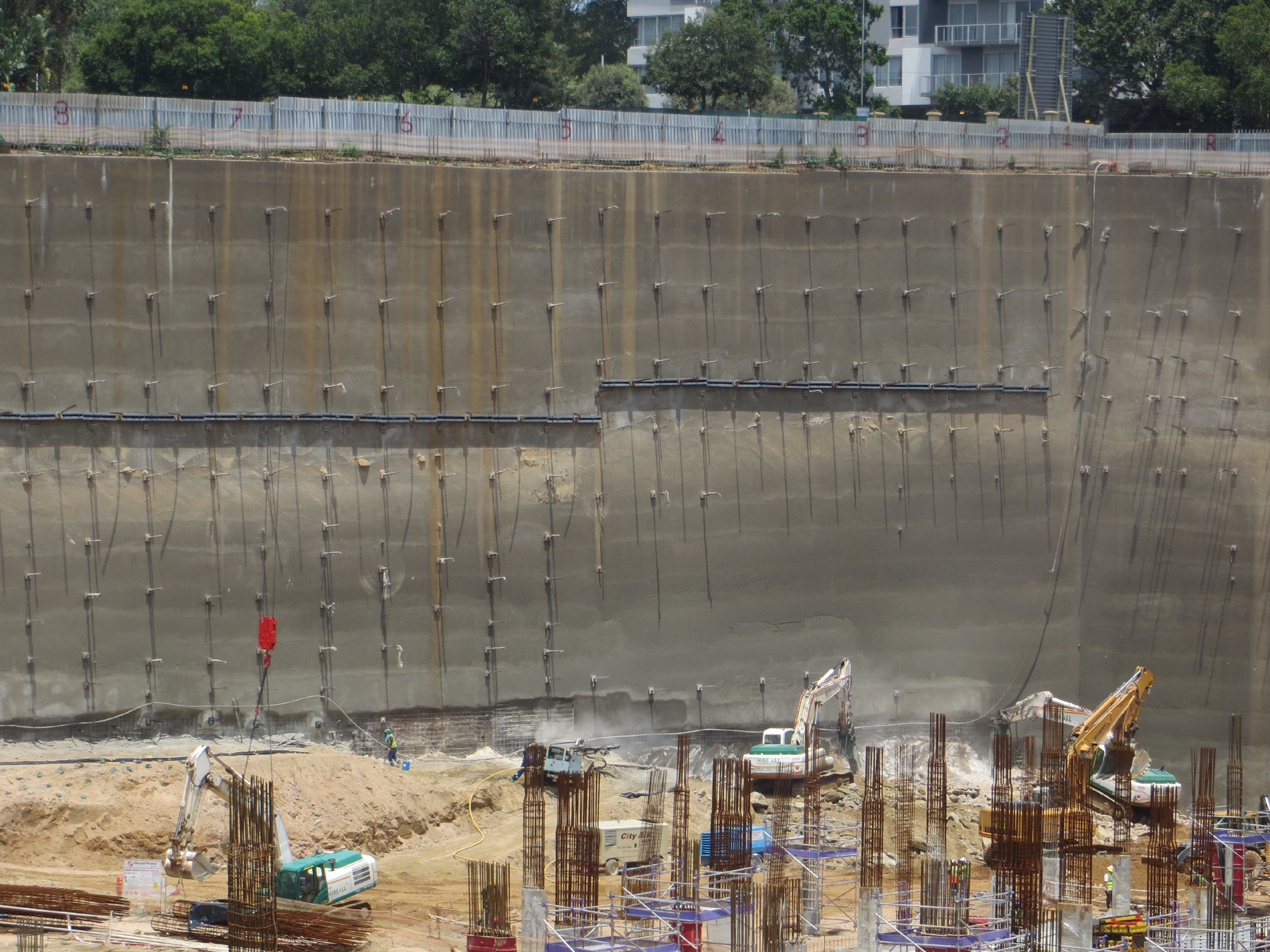Introduction
Franki Africa has dominated the geotechnical industry in the plethora of major developments that have been taking place in Sandton in the recent past. Two of its most recent contracts include the 170 000m³ basement for the new Sandton premises of petrochemical giant, Sasol, and the 60 000m³ basement for the new head office of legal firm Webber Wentzel. A third, perhaps the largest basement project undertaken ever in South Africa, the mammoth 550 000m³ excavation and
15 300m² of lateral support basement for the new Discovery head office, has been a prime example not only of Franki’s ability to work under pressure, but also to find the right solution in the face of challenging geological conditions.
Discovery Basement – a mammoth excavation
“While this is certainly one of the largest ever basements in this country’s history, it is definitely the largest ever for Franki,” says Franki’s Gavin Byrne. “The vast scale of the project is brought into clear perspective on the realisation that this will have required 110 000 X 10m³ truck trips (there and back) to dispose of the soil. Given that the site is in one of the busiest traffic areas in all of Africa, it is no wonder that this element of the contract was crucial in its overall ‘critical path’.
The development is being undertaken by Growthpoint Properties and Zenprop Property Holdings who awarded the contract to the JV of Diesel Power and Zero Azania, with Franki Africa as a nominated sub-contractor. The western boundary of the site, where the excavation is at its deepest (32m) is on Rivonia Road, the northern boundary on Katherine Street, the new IBM development is on the southern border while on the eastern side there is a series of office blocks.
Byrne says that the available geotechnical information showed that the site was underlain by a granite bedrock at an average depth of about 15m below natural ground level, similar to several sites in the immediate vicinity of Discovery. “We decided on a well-established solution for this situation – soldier piles drilled to bedrock with ground anchors over the upper circa 15m and rock bolts and shotcrete below the pile-toe level within the granitic bedrock zone of excavation,” Byrne said.
The excavation face comprised a flat gunite surface proud of the soldier pile line to allow the gunite to be the final finish of the multi-level basement parking. “This, a departure from the more traditional soldier pile and gunite arch solution which has been in use for the last 20-30 years, results in an exceptionally smooth and aesthetically pleasing surface,” Byrne said.
The project commenced in February 2014 with the installation of 216 (No.) soldier piles of 600mm diameter down to bedrock approximately 15m-18m deep. The excavation followed in bench heights of about 2m around the perimeter with the ground anchors and gunite face being installed from the benches.
Unforeseen Challenges and the Revealing of Diabase Dyke
Normal earth-moving equipment was used for the excavation down to bedrock level but the hard granite bedrock had to be removed using controlled blasting techniques. “The shallowest bedrock was encountered on the the north-western corner of the site and blasting commenced from approximately 6 meters below surface level.
He adds that it was also noted at this time that rock levels on the south-eastern portion of the site were much deeper than had been anticipated from the initial geotechnical investigations. “This significantly deeper soil profile was also accompanied by a much higher localised water table condition resulting in substantial movement of the lateral support system,” Byrne said.
These complex Geological conditions meant additional geotechnical investigation of the site needed to be undertaken. “The geotechnical conditions highlighted by the additional investigative drilling undertaken by Franki revealed a very complex Diabase dyke along most of the Rivonia Road boundary. We also found that there was a deeper weathering of the granite bedrock in the area surrounding the intrusion,” Byrne says. This resulted in the provision of additional anchor force than had been initially planned, with the corresponding reduction in the rock excavation and blasting requirements.
The expertise of Peter Day, a well-known and recognised Geotechnical engineer, was utilised by the Discovery team and his review of Franki’s assessment and design for the complex conditions encountered was much appreciated by all parties.
New Requirements, New Challenges
Byrne says that perhaps the biggest challenges for Franki was the doubling of the anchor forces required to provide satisfactory stability to the excavation face and limiting the movements of the site surrounding the excavation face. “This process required sophisticated and complex finite-element calculations to model the behaviour of the excavation as construction proceeded,” Byrne says.
He added that the difficult conditions encountered also required extensive and frequent movement monitoring of the excavation and its surrounds. “The complex analysis as well as the detailed monitoring programme enabled the use of an observational and interactive design approach to accommodate the highly variable conditions on the site,” Byrne said.
The contract commenced in February 2014 and was completed on 17th February 2015.
Teamwork
Franki’s Paulo Alves says that all the recent Sandton basement work could not have been undertaken without exceptional teamwork. “It has been a privilege working in a team with Zero Azania, Diesel Power and Pro-Frag Blasting on this job. Unless there is harmony and teamwork between all the players on complex geotechnical sites, all the expertise and experience in the world can mean very little and the Discovery contract is a prime example of how engineering and related teams can work together to produce world class results,” Alves says.
For all these jobs Franki Africa utilised up to seven lateral support teams and three Soilmec SR 30 drill rigs, which proved to be invaluable in the speedy and efficient drilling and installation of the soldier piles. “Balance between quality and time is always the issue in projects with tight timing and these machines as usual proved to be significant in us maintaining this balance,” Alves concludes.

